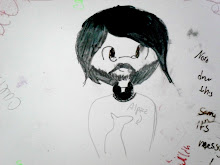













1. The morning went mostly like this - fairly calm studying in the Centro de Estudios with Claudio and Virginia.
2. Then...LUNCH, prepared by the culinarily-skilled, but camera-shy, Ana.
3. The kids for the afternoon program showed up shortly thereafter...and amazingly, this was NOT how somehow ended up going to the hospital for X-rays.
4. Fabiana and I worked together for the day; as you can tell, she´s a great hit with the kids of all ages....and, ok, with the adults, too. If she´s talking, there´s a good chance she´s joking.
5. During the mid-afternoon break, and sometimes before or after it on the sly, the boys have taken to playing marbles...which sometimes become so distracting that we have to take them up. I had a pocket full of them for half the day, which made the teaching-the-kids-how-to-play-basketball work that much harder. That, and my lack of basketball skills...but I at least made sure everyone knew that Manu Ginoboli plays for MY team - Go Spurs!
6. While the boys play marbles, the girls get out the jump ropes, taking turns between turning the rope and jumping.
7. This is Anita, one of the new students this year. She just started school in March, and is one of the sweetest, most well-behaved 6 year olds I´ve met. Her older siblings - Yeferson and Romina - also come to La Obra in the afternoon. Note in the background Natalia and Fabiana drinking mate while some of the girls hang out with them for girl talk...or to wait for the ambulance. Carolina fell during basketball and hurt her wrist; it was serious enough that she had to go have X-rays taken.
8. After break, we lined up the younger kids (Escuelita 1) for game time. It went fairly well, but eventually got a little out of hand, so we called it a day and moved inside for homework-and-reading.
9. Aldo, Jonathan, and Alejandro...oh my. Three very good kids, but ones fully capable of being handfuls. Aldo I´ve talked about before; Jonathan is new and I´m just getting to know him; Alejandro has decided that my friend and fellow volunteer, Kristina (in La Plata), must be my girlfriend since she came to visit us in Montevideo...that was in February, and he´s still making jokes about it.
10. Leticia and Anita decided to share a book - Anita doesn´t know how to read yet, so Leticia was helping her out a little bit. I´d also read a story to her and another girl who hasn´t learned to read yet, and also read with some students who can read, but need a little help now and then with bigger words.
11. Robert is one of the big kids in Escuelita 1 this year. He seems to have grown up a lot, in about every way, since I got here in September...but still gets a little TOO competitive at game time. Of course, so did everyone I went to high school with, including me.
12. Emilia, a new girl whose name is escaping me (bah!) , and Juanita. Their facial expressions tell you a LOT about their personalities. A lot.
13. Juanita is new this year, and like Anita, just starting primary school. She´s a very sweet, very emotional kid.
14. To wrap up the day, the kids get to have a snack - last Wednesday, it was cake and licuado (like a smoothie, but no cream). Obviously, they get pretty excited by this.
So, that´s a day at La Obra Ecumenica Barrio Borro...a long day, but a good one filled with some of the neatest kids and co-workers I can imagine.































